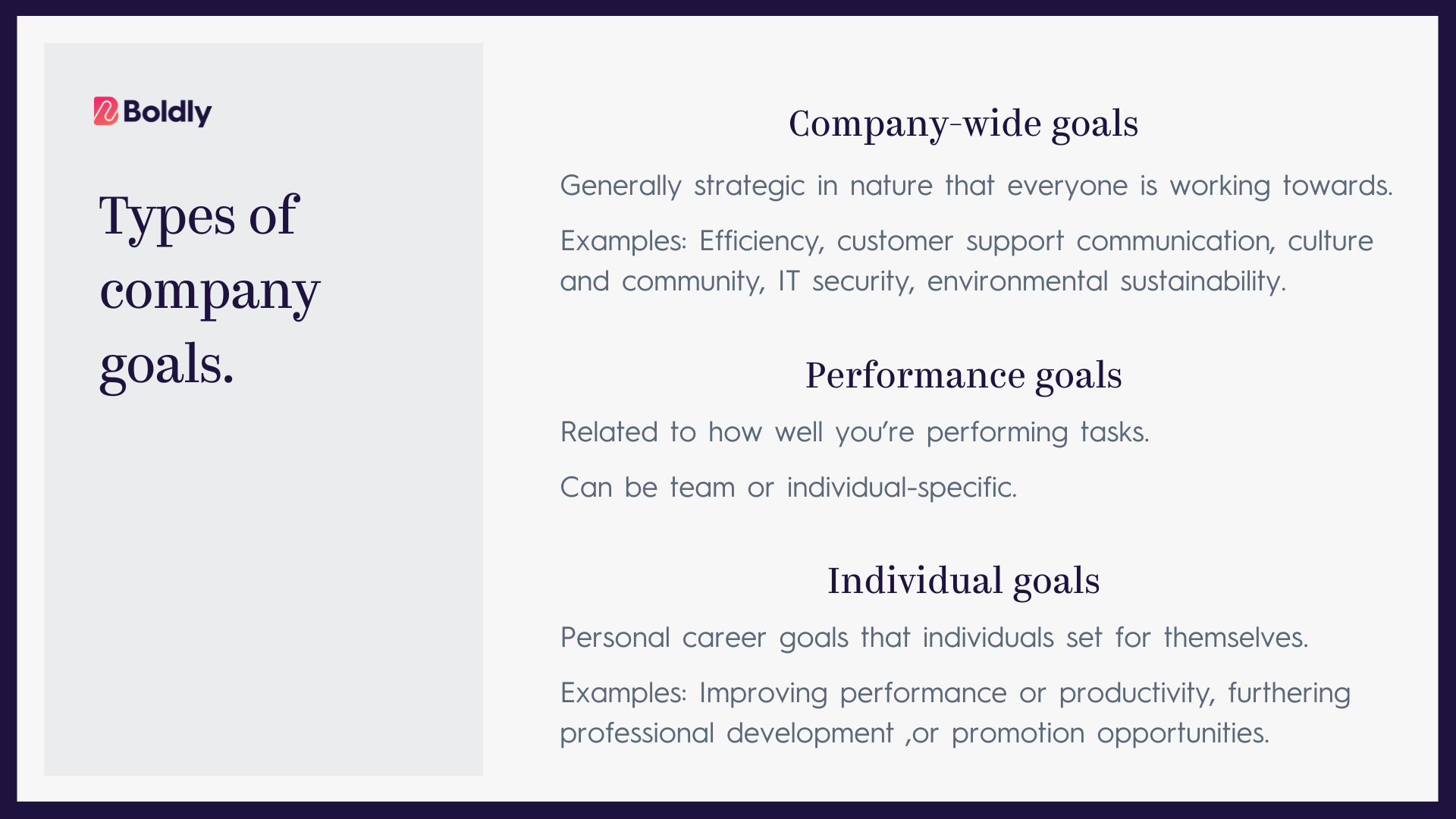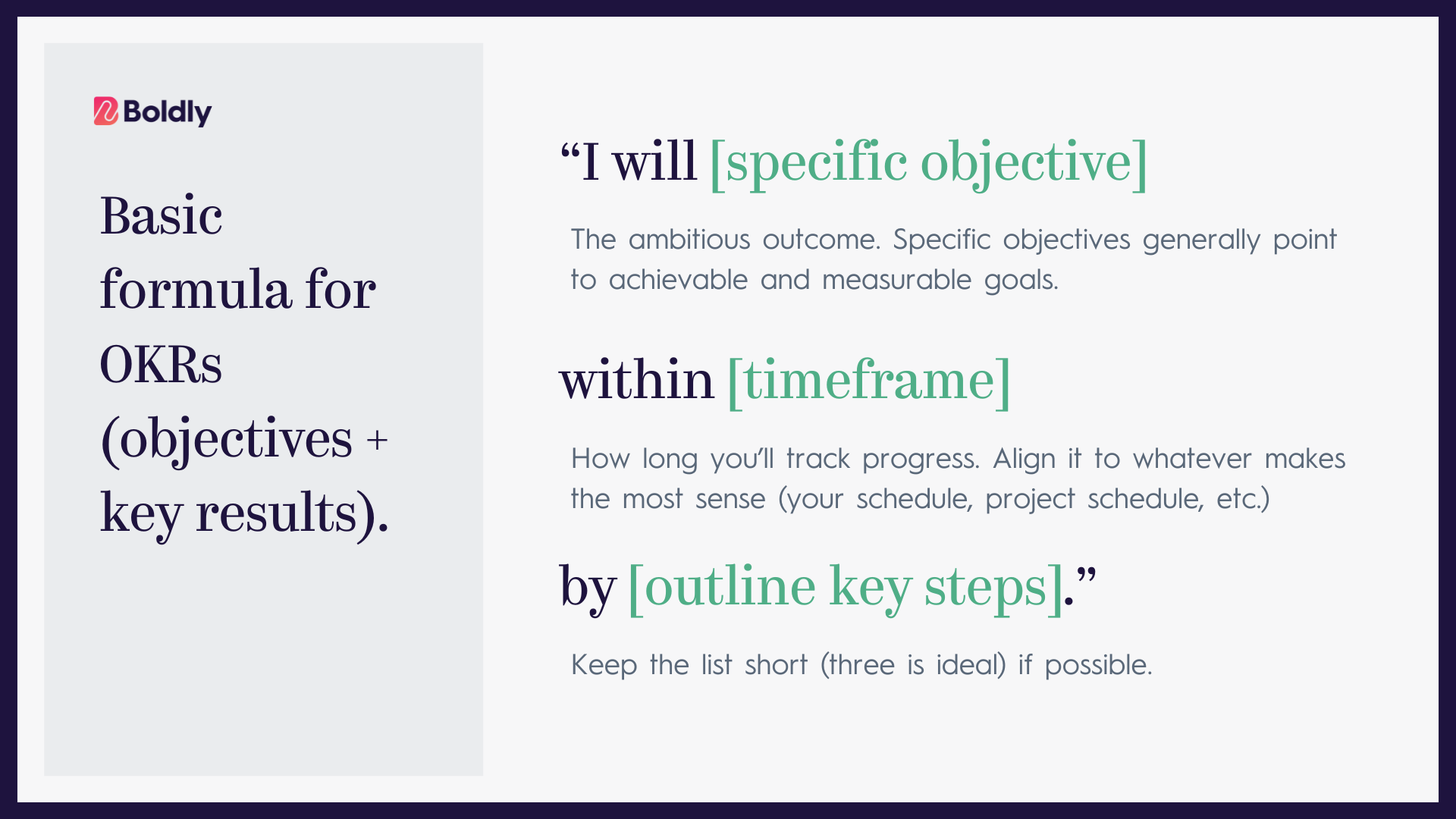Executive assistants do just about everything.
On paper, an EA’s role ranges from scheduler, to email manager, researcher, writer, and bookkeeper—but beyond that, premium executive assistants are trusted partners. They’re able to hold their own (while representing you) at C-level meetings or fast-track the right opportunities directly to you. And they do it with an understated tact that makes it all look seamless.
So how do you create an executive assistant goal (or goals) when the range is so broad and their duties change within a day (or hour)? What smart goals for executive assistants make sense?
Do more? Do less? Faster? Slower?
You have executive assistant goals coming at you from all directions, and goal setting isn’t easy. When there’s so much to do, there’s not a lot of time to slow down and think about what could improve, and how to improve it.
This is where setting objectives and key results (OKRs) come into play.
Objectives for executive assistants are different from typical office objectives. We’ll show you the different ways to approach OKRs and goal setting, and which ones work best for busy executive assistants who want to be able to track performance and see measurable improvement as needed.
If you want to jump directly to our example OKRs, click here.
Types Of Goals For Office Staff, And Why They’re Not OKRs


Without goals, things stay the same.
Not all goals are created equal, though. There are different types of goals at work within your team.
- Company goals. Overall, there might be a broad company goal that everyone is aiming for. These kinds of organizational goals are generally strategic in nature. They might cover efficiency, customer support and experience, communication, culture and community, IT security and best practices, or environmental sustainability. They are goals that help you understand the policies in place as well as guide you in how you do your work. They are the why behind the what.
- Performance goals. These goals are about how well you are performing your tasks. These might be team-specific, or individual. They can be measured differently, which we’ll talk about in a bit.
- Individual goals. These are personal career goals that individuals set for themselves. They might range from improving performance or productivity to furthering professional development and promotion opportunities.
While some of these types of goals might apply broadly across the organization to everyone, subgroups, like teams or departments, will have their own versions.
The sales team might want to increase sales on a specific product line. The administrative team might want to improve how they use meeting time. The customer service and onboarding team might want to improve their response rate and time. The marketing team might want to increase social media engagement.
As an executive assistant, smart goals examples are different. You might be on several or all of these teams because your duties are so broad. On top of that, maybe you also have that personal goal you want to achieve—like better organizational skills, keeping up with the latest AI or project management tech, or increasing your network—that’s not part of any team or organizational goals. Executive assistant objectives are truly unique.
So, enter OKRs, popularized by John Doerr, the VC who funded Google, Intuit, and Amazon.
OKRs are different from your average goal. They’re specific, bold, and a bit more aggressive. And the best thing about an OKR?
It forces you to define the objective.
Creating OKRs For Executive Assistants
Consider the popular method of creating goals using the SMART goals method, which says that useful goals should be:
- Specific
- Measurable
- Achievable
- Relevant
- Time-bound
The planning process for creating an OKR has that same underlying structure. There are three basic parts to an OKR:
- Objective. The ambitious outcome you want to achieve. Usually specific, objectives generally point to both achievable goals and measurable goals.
- Timeframe. Choose how long you will track your progress. Align it to your own schedule, the company schedule, project schedule, or whatever makes the most sense.
- Key results. List the results that should be achieved, with the easiest result first and the most difficult last. Keep the list short (three is ideal) if possible.
Consider the previously mentioned sales team goal of increasing sales on a specific product line. An OKR would say they want to increase those sales by 40% this quarter, and then list the steps they will take to make it happen.
It’s bold, specific, and measurable. And, because it’s less broad, it reduces the burden that vague goals can have on those trying to achieve or measure them.


15 Examples Of Specific And Measurable OKRs For Executive Assistants
You might want a specific list of examples of goals for executive assistants, but a better approach is to consider the areas where goals make sense.
As an executive assistant, your goal might be to improve at communication, help your executive better, or stop dreading the use of a certain app. Wherever there’s room to improve or increase performance beyond typical boundaries, there’s an OKR for it.
We have some examples of smart goals for executive assistants, all of which use this formula: I will [specific objective] within [timeframe] by [key steps].
- I will improve my writing skills in the next 30 days by reading The Elements of Style by Strunk and White and applying one principle each day.
- I will become comfortable using AI in the next six months by practicing and researching prompts, using AI every day in some form in my work, and learning to make informed recommendations on how my whole team could use it.
- I will learn to run Quickbooks expense reports in half the time it takes now by EOM.
- I will read 3 business management books and create a list of 10 actions that will help find areas to help my executive be more efficient and effective.
- I will reduce office supply costs by 20% at the end of this quarter by finding alternate vendors with better pricing but with the same-quality.
- I will stop scheduling meetings during my executive’s peak productivity times starting today.
- I will find five products or tools we can either use more effectively or eliminate within the next 7 days, and share a short report with my manager.
- I will find 3 more tasks my executive can either delegate to me or help automate them by our next progress meeting.
- I will improve my writing quality by editing every memo with Hemmingway Editor before I send it.
- Starting today, I will eliminate or shorten meetings by asking what my exec needs to accomplish before scheduling any meeting.
- I will reach out to team members 48 hours before key project deadlines to surface issues that could derail our projects.
- I will get feedback from customer success on what our customers like best, and least, about our new service 1 week before the next leadership offsite.
- I will pull my exec’s LinkedIn stats each week to see what content has resonated most with our audience, tracking engagement, content type, posting time, and valuable connections.
- I will reduce my executive’s travel days 10% by finding teleconference opportunities or combining meetings into single trips starting next quarter.
- I will create SOPs for 5 tasks to decrease meetings, mistakes, and onboarding time by EOW.
Feel free to use the examples above or use them as inspiration to write your own OKRs!
The best objective for an executive assistant is the one that fits your specific situation.
When you get bombarded by goals and performance measurements, break them down by defining them into OKRs that will serve the larger purpose. They are much more manageable because they have a specific plan of action built in. They force you to grapple and define what improvement looks like, and how you will get there.
Word of caution, though: while not all OKRs are as easily measured as others, OKRs that are unrealistic or unmeasurable are discouraging and do very little to improve performance or accomplish outcomes. Bold and ambitious OKRs are good, impossible OKRs are not.
KPIs vs. OKRs For Team Projects And Goals
OKRs are not the only option, nor are they always the best option.
Within an organization, preferred outcomes are not always the same. Sometimes you want to stay steady, sometimes you want bold change or accomplishment.
There are times when using executive assistant key performance indicators (KPIs) to measure individual and team performance using established metrics as a comparison is optimal. Key performance indicators for executive assistants are great for repeat projects, scaling projects, and tracking how the project is progressing. An executive assistant KPI is defined by what, why, how, who, and when.
OKRs, however, push the envelope and encourage more ambitious achievement. When expanding your vision and creativity, or doing something big and bold with the project is what you want, OKRs are a better way to go.
Executive assistant KPIs and OKRs both have one thing in common: measurement.
KPIs for executive assistants can work well hand-in-hand with OKRs. Both approaches, though subtly different, do build measurement into the process. You can’t know if you’re on track or improving if you’re not measuring.
Your OKR Plan Involves Feedback
Your OKR plans—those big goals—necessarily affect the executive you support.
That means you should run them by your executive to be sure there aren’t any problems or conflicts with what you’ve set out to do; you might even ask for suggestions and get their feedback.
Feedback goes both ways.
Read more: A Guide To Executive Assistant Performance Reviews
By sharing your OKRs with your executive, you’re letting them know that you’re serious about professional development and improvement, that you’re aware of areas you need improvement, and that you don’t mind if someone holds you accountable to your goals.
Having someone else in on your goal setting will help you in the long run, both in keeping you from setting impossible goals, but also to keep you honest about how it’s going.
An OKR is a goal-setting tool that allows not only outside feedback and accountability, but has a built-in self-accountability that lets you know how well you’re doing. When faced with a lot of tasks and performance requirements, they bring clarity, focus, and self-empowerment.




